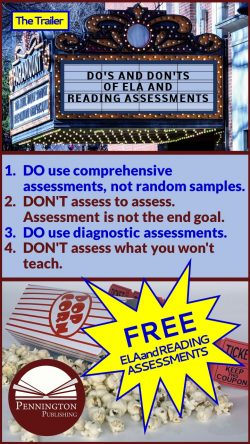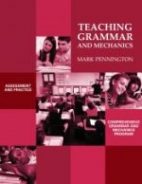ELA and Reading Assessments Do’s and Don’ts
As an ELA and reading intervention teacher at the elementary, middle school, high school, and community college levels (I know… the grass
is always greener :)), I’ve had the opportunity to learn the value of assessment-based instruction. So when a fellow teacher challenged me at a recent professional development workshop on assessment with the following rhetorical question, I answered quickly and moved on to the rest of my presentation.
She asked/stated, “Don’t you think it makes more sense to spend valuable class time teaching, rather than assessing?”
Later, I sat down at the computer to provide a more comprehensive answer. Happens to me all the time. I think of the really good answer, quip, or comeback later when the moment has passed. I came up with 52 solid reasons to support assessment-based instruction.
Now, I doubt if the teacher wanted to hear even my quick answer, let alone my 52-part answer. Don’t worry, you’ll only get the one reason in this article, but the rest will follow.
I’ve opted for a Do’s and Don’ts approach to clearly explain what does and does not “make sense” for ELA and reading assessments, but in classic movie sequel promotion, I’ll provide a cliffhanger to entice viewers to check out the next article. More Do’s and Don’ts probably won’t bring everyone back into the theater and sell more popcorn (Yes, my ELA and reading intervention resources are for sale in the lobby at https:\\www.penningtonpublishing.com); however, my 15 free ELA and reading assessments, with corresponding matrices, administrative audio files, and ready-to-teach lessons just might do the trick. Tell you what… I’ll kick start this first episode with two assessment freebies. So, dim the lights because the “coming to a theater or drive-in near you” trailers are over and the feature now begins. Please silence your cell phone.
Do’s and Don’t of ELA and Reading Assessments
1. DO use comprehensive assessments, not random samples.
As an ELA teacher and reading specialist, I certainly value random sample normed assessments. In fact one downside of the Common Core State Standards was the replacement of nationally normed assessments. The new PAARC, SWBAC, and other state iterations are criterion referenced (the Standards) achievement tests, not statistically normed tests. For example, we used to be able to state the reading comprehension and vocabulary grade levels percentiles for individual students, but no longer.
 However, to be honest, the normed assessment data did not inform instruction (and frankly, the CCSS assessments do only marginally better). What both the normed and Standards-based tests provide are random samples of ability or achievement, respectively. In other words, they can accurately state, “Houston, we’ve got a problem.”
However, to be honest, the normed assessment data did not inform instruction (and frankly, the CCSS assessments do only marginally better). What both the normed and Standards-based tests provide are random samples of ability or achievement, respectively. In other words, they can accurately state, “Houston, we’ve got a problem.”
However, knowing that there is a problem is of limited value. Back in 1970 the NASA team in Houston worked round the clock to test what would and what would not work to help the three Apollo 13 astronauts survive and make the re-entry into the Earth’s atmosphere. Their specific data were informative and applicable to the astronauts. They made it home alive! (if you haven’t seen the movie).
Identifying the fact that a student has a problem is not helpful data. What teachers want are comprehensive assessments which specifically determine “What my kids know and what do they not know.” The Standards-based tests may permit some ability grouping or class placements, but the data do not target instruction. Following are two quick, but comprehensive small group or whole class assessments with recording matrices, which provide specific data that will provide exactly what each individual student has an has not yet mastered. I’ve included one for Pre-K, grades 1, 2, 3 and reading intervention, English-language development, and special education teachers, and one example for grades 4 through adult learners.
Assessment #1: The Alphabet
It may come as a shock to secondary teachers that many older students do not yet know the alphabet. Of course, this comes as no surprise to those who work with struggling English readers. One of the most popular reading intervention programs, Read 180, includes the normed Foundational Reading Assessment. The test provides 10 items designed to measure students’ knowledge of uppercase and lowercase letter names.
Last I checked, the English alphabet has 26 letters. Teachers want to know precisely which upper and lower case letters students can name, identify, match, and sequence and which ones they cannot. A comprehensive alphabetic assessment provides these data. Download it below.
Assessment #2: Sight Syllables
The Standards-based assessments may be able to accurately summarize that a student has not yet mastered sight syllable recognition of the common affixes through random sample test problems. However, from the test results we can’t learn exactly which of the common Greek and Latin prefixes and suffixes a student has and has not yet mastered in terms of syllable recognition. The former doesn’t help the teacher; the latter could transform a teacher’s instruction and student learning. A comprehensive assessment on the research-based, high frequency Greek and Latin prefixes and roots provides these data. Download it below.
COMING ATTRACTIONS!
Enough for now. But, get your ticket for the next installment of ELA and Reading Assessments Do’s and Don’ts: Episode 1 and get more 15 FREE ELA and reading assessments, corresponding recording matrices, administrative audio files, and ready-to-teach lessons. A 95% score on Rotten Tomatoes! Here’s the preview.
2. DON’T assess to assess. Assessment is not the end goal.
3. DO use diagnostic assessments.
4. DON’T assess what you won’t teach.
*****

The Science of Reading Intervention Program
The Science of Reading Intervention Program: Word Recognition includes explicit, scripted instruction and practice with the 5 Daily Google Slide Activities every reading intervention student needs: 1. Phonemic Awareness and Morphology 2. Blending, Segmenting, and Spelling 3. Sounds and Spellings (including handwriting) 4. Heart Words Practice 5. Sam and Friends Phonics Books (decodables). Plus, digital and printable sound wall cards and speech articulation songs. Print versions are available for all activities. First Half of the Year Program (55 minutes-per-day, 18 weeks)
The Science of Reading Intervention Program: Language Comprehension resources are designed for students who have completed the word recognition program or have demonstrated basic mastery of the alphabetic code and can read with some degree of fluency. The program features the 5 Weekly Language Comprehension Activities: 1. Background Knowledge Mentor Texts 2. Academic Language, Greek and Latin Morphology, Figures of Speech, Connotations, Multiple Meaning Words 3. Syntax in Reading 4. Reading Comprehension Strategies 5. Literacy Knowledge (Narrative and Expository). Second Half of the Year Program (30 minutes-per-day, 18 weeks)
The Science of Reading Intervention Program: Assessment-based Instruction provides diagnostically-based “second chance” instructional resources. The program includes 13 comprehensive assessments and matching instructional resources to fill in the yet-to-be-mastered gaps in phonemic awareness, alphabetic awareness, phonics, fluency (with YouTube modeled readings), Heart Words and Phonics Games, spelling patterns, grammar, usage, and mechanics, syllabication and morphology, executive function shills. Second Half of the Year Program (25 minutes-per-day, 18 weeks)
The Science of Reading Intervention Program BUNDLE includes all 3 program components for the comprehensive, state-of-the-art (and science) grades 4-adult full-year program. Scripted, easy-to-teach, no prep, no need for time-consuming (albeit valuable) LETRS training or O-G certification… Learn as you teach and get results NOW for your students. Print to speech with plenty of speech to print instructional components.
I’m Mark Pennington, ELA teacher and reading specialist. Check out my assessment-based ELA and reading intervention resources at Pennington Publishing.
Get the Alphabet Assessment, Matrix, Activity, and Game Cards FREE Resource:
![]()
Get the Sight Syllable Greek and Latin Assessment, Matrix, Activity, and Game Cards FREE Resource:
![]()
Grammar/Mechanics, Literacy Centers, Reading, Spelling/Vocabulary, Study Skills, Writing




